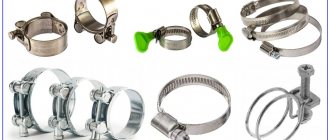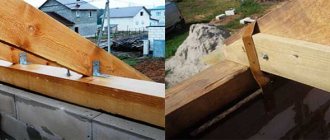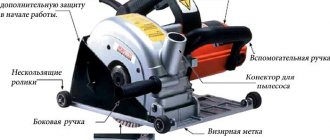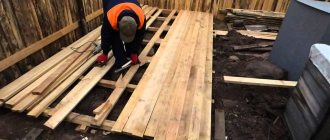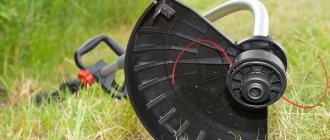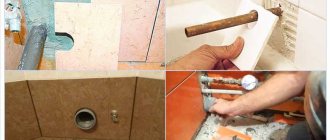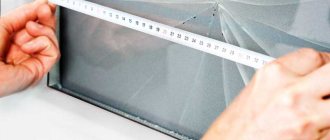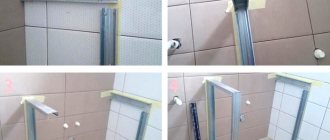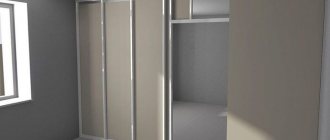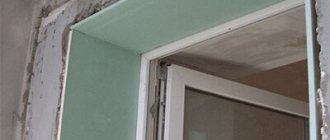| Place | Name | Characteristics in the rating |
| TOP 10 best profile cutters |
| 1 | BISON “MASTER” | The best tool steel |
| 2 | SIBIN 313 | A simple tool at an attractive price |
| 3 | Matrix 87951 | High quality lever system |
| 4 | DEXX 31391 | Best price |
| 5 | STAYER "GRAND" | The most reliable design |
| 6 | Enkor 300mm | Strengthened system |
| 7 | Sibin | A cutter with an enlarged mouth |
| 8 | Bison 3135 | The most convenient one-handed model |
| 9 | Brigadier | Presence of a rotating head |
| 10 | Knipex KN-9042250 | The best choice |
A cutter is a tool that allows you to quickly connect metal profiles to each other without using additional fasteners. The principle of its operation is to punch holes at the joints and simultaneously roll the edges. Thanks to this technique, we get a durable structure for drywall, and the main advantage of such fastening is the speed of construction.
When choosing a cutter for a profile, you should pay attention to the following factors:
- steel quality;
- reliability of the mechanism;
- ergonomics of handles;
- the presence of a lever mechanism, or its absence;
- punch size.
Most aspects are easy to determine by eye, except for the build quality and the steel used. You can’t do this without personal experience or reviews from real users. We also studied them and took them into account when compiling our rating, which included the 10 best models with which you will not experience any inconvenience when working. The TOP included both the most popular manufacturers, who often inflate the price just for their name, and little-known brands from Asia, which are also distinguished by their high quality and compliance with all stated requirements. We will look at both cutters with a reinforced punch and the simplest lever-type tools, which cost less, but are less convenient during operation and force the master to exert increased effort when pressing the levers.
What is a sheet metal cutter?
A cutter or punching pliers is a hand-held tool for joining sheet metal products. The connection occurs due to the formation of a through hole in the parts being connected. The parts to be connected are fixed by bending the resulting metal petals. That is, to connect sheet metal products using a cutter, no fasteners or additional actions are required.
We placed the working part of the tool in the right place and pressed the handles. The metal breaks through, its pieces bend. All. Due to the fact that the metal is “pierced”, another name for this tool came to be - a profile punch. The same tool can be found under the name “pliers for connecting HA profiles.” This is exactly how some manufacturers position it. There are other names - perforation, profile hole punch. This is already from the jargon of builders and home craftsmen.
Metal profile cutter: roller type device
Externally, a cutter is the same pliers, but with long handles and an unusual structure of the working part. Like regular ticks, they have two jaws, but they are different in shape. On one side there is a stop, on the other there is a punch. A punch is a protruding part that makes a hole in metal. The stop is a thickened part with a hole into which the punch fits.
Measuring tools for working with drywall
The work cannot be done without measuring tools for drywall. To avoid errors and inaccuracies, you need to accurately mark the sheet. The standard tools used for this are a tape measure, a building level, a corner, and a plumb line. But you cannot limit yourself to this set - there are many plasterboard structures, the assembly of which also uses other tools.
Metal tape measure
A flexible metal strip with markings in millimeters and/or inches in a plastic or metal case, the standard length of the tape measure is from 3 to 5 meters. But if necessary, you can purchase 10-15 meter tape measures
Building level
The level controls the deviation from the horizontal and/or vertical of the gypsum board sheet. The level body can be aluminum or made of metal alloys; ampoules with liquid are built into it, usually colored for better visual observation of the air bubble inside. Some levels are equipped with magnets that help secure the tool to a metal surface.
Metrostat
The sliding measuring tool has a scale and level, the average size of the tool is 3 m. The metrostat controls the horizontal and vertical positions of the plasterboard structure. The metrostat attachment helps to hold the drywall board vertically during installation.
Hydraulic level
This is a long silicone transparent hose, 10 or more meters long, into which water is poured so that the level can be checked at spaced positions of the structure. The hydraulic level is also convenient for transferring marks. The water level is designed for working with surfaces at height.
Laser level
The most convenient measuring tool for drywall is a laser level. The simplest linear plane builder (laser level) allows you to construct any projections of the future surface with great accuracy by intersecting rays.
Laser level with rotating head
In a rotating laser device, the beam rotates 360˚, which allows you to project surface points over the entire coverage. A rotating laser level is used in large areas where the use of other levels is impossible.
Square
A square (angle) is used when marking corner surfaces to obtain an accurate value of 90˚. Structurally, it is a metal ruler molded at an angle of 90˚ into a thick steel base.
Types and designs
The assortment of cutters in our stores is not so large, but in large construction stores you can see about a dozen different models. What are they? First, there are models for sheet metal (pictured below). They have a very small gap in the working part, which is also called a “window”. For sheet metal cutters, this window is only about a centimeter wide. Any metal will fit there, but the profile for drywall is only a guide (PN) or rack-mount (PS) with small shelves. And then there may be problems.
A cutter for a metal profile should have a larger “window” in the working part
If we talk about models for connecting drywall, they have a larger “window”. It is made in the form of a square, rectangle or with rounded corners. The larger the window, the easier it will be to fasten rack profiles with any shelf width. But then the size of the “head” increases, which is not always convenient. Professionals simply have several different tools, and for repairs and household use they choose something in between.
This is already a tool for professionals - with holes of different sizes and shapes
There are also different shapes of holes: rectangular, round, square. They come in different sizes. The thicker the metal, the larger the punch (or bit) required. There are models with replaceable punches, and there are rotary ones. For rotary or revolving ones (pictured above), the attachment is changed by turning a wheel with bits of different shapes and sizes. If you plan to work with sheet metal often, this is a good thing. For occasional use, such luxury is unnecessary.
You can fasten profiles near the ceiling and floor with a regular tool, but it is more convenient to work with a special
There is also a cutter for metal profiles for convenient fastening of profiles under the ceiling or near the floor. Their handles are not a continuation of the working part, but are installed at an angle. Some (Ultra Profil EDMA) are at an angle of 90°, others are at 45°. This tool further speeds up the work when creating frames for suspended ceilings.
One-handed and two-handed and principle of operation
It is also worth remembering that there are one-handed and two-handed models. One-handed ones have a return spring that opens the handles after the tension is removed.
Working one-handed is far from easy. Especially on good profiles made of normal metal. So often one-handed ones are still operated with two hands. In this case, the procedure for working with the cutter for KG profiles is as follows:
How the cutter works: it pierces both profiles, bends the edges inward
- We set profiles by level.
- With your left hand we fix them in the desired position.
- Tool on the right. We bring its working part to the desired point, compress it until the bit hits the metal.
- We remove our left hand (the profiles are “held” by the cutter), and squeeze the handles with both hands.
Two-handed work is different in that the handles are at such a distance that you can’t even grab them with one hand. Well, they are also designed to connect thicker metal.
Drywall Sanding Tools
Sanding float is a tool with clamps for a sanding mesh. The grater is used for dry sanding of puttied plasterboard sheets and the seams between them.
The variable handle grater is also equipped with clamps and a hinged handle. The grater is used in hard-to-reach places. The grater handle is extended, which allows you to increase the radius of surface treatment. This device allows you to go beyond the area with high dust formation when sanding gypsum boards.
Vibratory sanders not only speed up the processing of the surface of a plasterboard structure, but also collect dust in special dust bags.
Pros and cons of using cutters
This type of instrument is not very popular yet. It’s difficult to name the reasons, because the thing is really good. Especially for those who install plasterboard systems, and for home craftsmen, this is also a necessary thing. What are the advantages:
- Fast and reliable connection of profiles. The speed of installation of the frame under drywall increases significantly. The principle of operation is simple: insert the parts to be connected between the jaws, squeeze the handles, move, repeat. And so on as many times as required.
Punch for drywall profile. This is also what this instrument is called.
For installing drywall, the absence of protrusions is definitely a plus
Few of those who have tried to work as a cutter return to self-tapping screws. Although, I must say, there are some. Sometimes in difficult places, the connection is “grabbed” with a self-tapping screw, then a cutter is used, and the self-tapping screw is unscrewed. But these are those who like to play it safe. With some work skill, additional fixation is not required.
Flaws
Now about the cons. Using a plasterboard profile cutter really saves time. But the tool is manual and requires the application of muscle force. With large volumes of installation, namely structures made from profiles, fatigue quickly accumulates. And by the end of the working day, the speed of work drops. The better the tool, the less effort is required, but it is still needed. And this is a minus.
The second drawback is the difficulty of disassembling. To separate the two profiles, you need to bend the metal petals. It takes more time than when unscrewing screws. But less than when removing rivets. It seems that these are all the difficulties and disadvantages of working with a cutter.
Not everywhere you can crawl up and make a cut. Then you have to use screws and a screwdriver
There is another drawback, which is due to the shape of the working part. Some components - jumpers, clamps - are simply impossible to “reach” with a cutter. The punch won't fit in there. There are models with very large “windows”, but they are not very good for regular connections. For professionals, having several different models is normal, but for home use it is clearly overkill.
Self-tapping screws or notches
It has already been said that when using cutters the sheet lies flatter. And this is a clear plus in favor of the expanded connection. The second unconditional plus is saving time. The third is the lack of consumables.
The disadvantages of joining GK profiles with a cutter include insufficient fastening strength. Self-tapping screws are more reliable. Perhaps, but the strength of the frame is needed only until it is sheathed with gypsum boards. And it will be enough, even if you make only one fastener for each connection. But it’s up to you to decide which is better - a cutter or self-tapping screws.
How to choose a cutter for a metal profile
Perhaps the most difficult thing is choosing a specific cutter model. They are divided, as usual, into household and professional. The difference in price is more than noticeable. The cheapest and most acceptable quality ones can be purchased for about $10, normal ones from $20-30, and really good ones can cost $100 or more.
Profile cutter for drywall: which one to choose
What is the difference? In work resource and ease of use. This means that the more expensive ones use more durable and expensive metals, rubber and plastic for handles, etc. They have a more complex design of the working part; there is a mechanism that reduces the force required for connection. In general, there is something to pay for. But nevertheless, for periodic work, for the home, you can find quite good and functional specimens in the cheap segment.
The difference in the working part between a regular inexpensive cutter and a professional one
When choosing a cutter for a profile from any category, look at the following parameters:
- Maximum thickness of fastened parts. Please note that the total thickness of metal that this tool can penetrate is indicated. That is, if 1.2 mm is indicated, this means that you can take two sheets of 0.6 mm or 0.8 mm + 0.4 mm, but not two sheets of 1.2 mm.
- Shape and size of the “window”. Rounded corners make work easier.
- The presence of a roller that pushes the punch. Such models are more expensive, but require much less effort.
- The case is free of defects, cavities, cracks, massive and heavy.
- We evaluate ergonomics. The handles should be comfortable, with stops.
- It is ideal if the handles have rubberized inserts. Otherwise, you will have to work with gloves - there will be calluses.
- The handles can be grasped with one hand when extended.
For professionals, such a tool is a godsend, but for amateurs and home craftsmen the price is too high
And it is very desirable that the company be well-known. Although, there are also nameless “Chinese” ones that are very good for home use.
Which is better: self-tapping screws or a cutter?
Builders' opinions on this issue differ. Some people still prefer to use self-tapping screws because they believe that fixation by twisting is more reliable.
Many craftsmen who work with drywall claim that a gypsum board cutter can only be used as an auxiliary tool. The device is unable to hold the profile and is not suitable for guides.
Other experts believe that the absence of fastening elements is ergonomically beneficial. With a cutter, there is no need to make markings before connecting the profile, which saves time. An alternative option for fastening a metal profile under plasterboard would be mixed fastening. All facial connections are made using a cutter. Others, the most important and hidden, are fixed with self-tapping screws.
Disadvantages of self-tapping screws
- Low productivity. It takes about 20 seconds to screw in one screw. (With a cutter, one fastening is completed in 6-7 seconds).
- Not always even twisting.
- The protrusion beyond the plane of the frame is 2-4 mm (the gypsum boards will rest against the cap and slightly adjacent to the frame at this point).
The cutter will never damage metal due to its design feature. To use the tool, you do not need any skills. It all depends on the strength of your hands when pressing. Skrepprofile optimizes installation work, making it more ergonomic. Even inexpensive models will provide reliable grip.
Thus, to connect the metal profile under the gypsum board, it is better to choose a cutter. It helps to make repairs quickly and efficiently. After working with this device, many builders refuse to use self-tapping screws. With it, the assembly of a metal frame for drywall is greatly simplified.
Disadvantages of installing a profile using a cutter
With all the advantages, there are also disadvantages. Many professional models have a high cost, so not all builders decide to purchase them so as not to increase costs. If used frequently or/and incorrectly, the device fails—the return spring breaks. This will require expensive and time-consuming repairs.
The scope of application of the cutter is limited to connecting metal profiles to each other. It is better to work with the tool while wearing gloves to protect your hands from calluses.
Putty tools
Tools for preparing the solution and applying it to the surface of the plasterboard must be made of stainless steel. The quality of a plastered or puttied surface depends on proper mixing of the solution. The mixture is mixed with attachments (construction mixers) inserted into a drill, hammer drill or screwdriver.
Nozzles for preparing the solution
- Use a mixer with a round paddle to mix paintwork materials, sealants and adhesive mixtures;
- The spiral nozzle with a ring at the end is designed for working with plaster mortars, fillers and leveling mortars;
- A left-handed three-turn spiral nozzle is needed for mixing liquid compositions with a low viscosity coefficient;
- A right-hand spiral nozzle is needed for preparing heavy solutions with a high density coefficient;
- The screw ring nozzle is designed for primers, paints and varnishes, adhesive mixtures and spray solutions.
Spatula
- Using a spatula with a 50-70 cm blade, seal the seams between the plasterboard slabs, press the reinforcing tape into the solution to fasten the seams between the gypsum boards, apply putty along the long side of the seam and on the entire sheet;
- Using a narrow corner spatula, level the outer and inner corners of the gypsum plasterboard structures, and also seal the transverse seams;
- Using a spatula and a screwdriver, putty the gypsum board seams and the recesses from the screw heads;
- Using a wide spatula with a blade length of 180 cm, plasterboard slabs are completely puttied;
- A putty falcon is a stainless steel shield on which a solution is applied and brought to the place of putty.
Advantages
Installation of drywall profiles using a cutter differs from the classic method using self-tapping screws. Ticks have significant advantages:
- Significant savings for large volumes.
- Energy independence. The tool can be used anywhere. Its action is purely mechanical.
- No need to make markings.
- Profiles are not subject to deformation.
- The holes are neat, with smooth edges.
- No additional tools (drill, screwdriver) are required to carry out the work.
- There will be no dents left on the frame.
With the help of a cutter, a hole is punched faster than a self-tapping screw is screwed in, and there is no risk that it will go far. Thanks to the profile pliers, the connections are reliable. If necessary, they can be easily disassembled.
